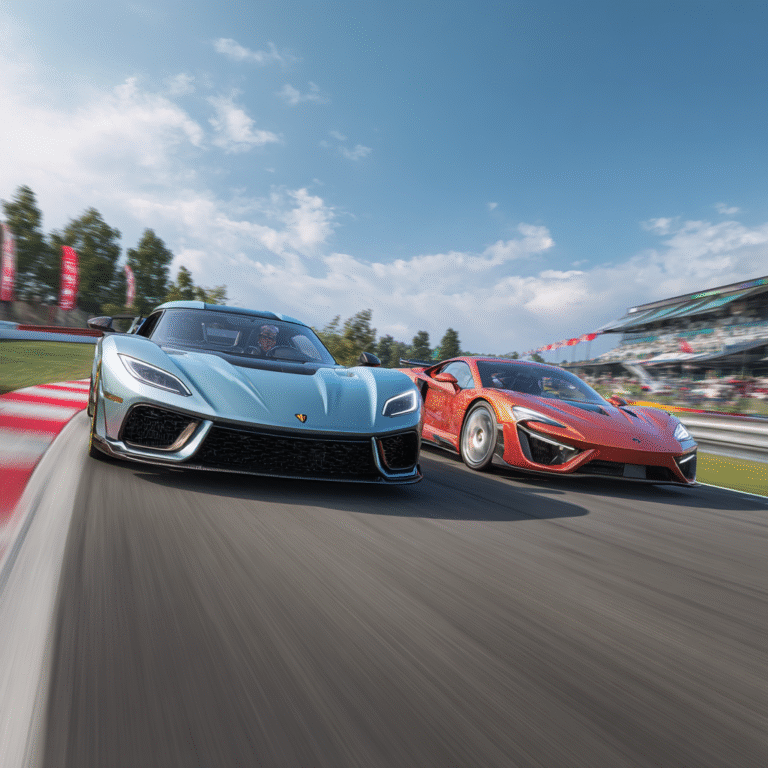TL;DR:
- Explore the definitions and functions of turbochargers and superchargers, noting that a turbocharger utilizes exhaust gases to increase air intake, while a supercharger is mechanically driven from the engine.
- Understand the benefits of turbochargers, such as improved fuel efficiency and performance at high RPMs, against drawbacks like turbo lag. Conversely, superchargers provide immediate power response with a drawback of higher fuel consumption.
- Compare performance metrics: turbochargers excel at high-end power, while superchargers are better for low-end power, affecting overall fuel efficiency.
- Discover which technology suits different driving styles: turbochargers for efficient daily driving and superchargers for performance enthusiasts, also considering their behavior in various weather conditions.
- Determine the best choice for your ride in 2025 by evaluating factors like vehicle type, potential future modifications, and your specific driving needs in the context of the turbo vs supercharger debate.
Introduction
Turbo vs supercharger, which is better? This age-old debate sparks excitement among car enthusiasts and weekend racers alike. As we shift into 2025, a new era of automotive technology beckons. Both turbochargers and superchargers promise that exhilarating boost in power, but the right choice for your ride depends on your driving style and preferences. From instant throttle response to high-end power delivery, understanding each technology’s strengths and weaknesses will elevate your vehicle’s performance. Let’s dive into this riveting comparison and help you make an informed decision that aligns with your automotive dreams.
What is a Turbocharger?
A turbocharger is an ingenious piece of technology designed to enhance engine performance by increasing its efficiency and power output. By compressing air entering the engine, a turbocharger allows for more fuel to be burned, leading to increased power without significantly increasing the engine size. For enthusiasts and everyday drivers alike, understanding the benefits and limitations of a turbocharger is essential, especially when considering the age-old debate of turbo vs supercharger which is better.
How Does a Turbocharger Work?
The operation of a turbocharger revolves around a simple principle: utilizing exhaust gases to create a vacuum that pulls in more air. This process involves two primary components—a turbine and a compressor. The turbine spins due to the exhaust gases exiting the engine, which in turn drives the compressor to draw in more air. This additional air allows for better combustion, resulting in enhanced engine performance.
What Are the Benefits of Using a Turbocharger?
Turbochargers offer several advantages that make them appealing to drivers:
- Increased Power: Up to 30% more horsepower without adding extra weight.
- Fuel Efficiency: By burning fuel more effectively, turbocharged engines can deliver better mileage compared to naturally aspirated engines.
- Lower Emissions: Improved fuel combustion leads to fewer harmful emissions being released into the atmosphere.
What Are the Drawbacks of a Turbocharger?
Despite their benefits, turbochargers do come with a few drawbacks:
- Turbo Lag: The delay in power boost can be noticeable as the turbocharger does require time to spool up.
- Higher Cost of Maintenance: Turbochargers can be more complex to repair and replace, often leading to higher maintenance costs.
- Heat Issues: Increased heat generation can affect engine longevity if not properly managed.
Understanding both advantages and disadvantages is pivotal for anyone looking to optimize performance within their vehicle. Whether you’re intrigued by turbo vs supercharger which is better, knowing the nuances will help you make an informed decision for your driving style.
What is a Supercharger?
A supercharger is a mechanical device that compresses the air entering an engine, allowing for more air to be forced into the combustion chamber. This results in an increase in power output and efficiency, making it a popular choice among performance car enthusiasts. Understanding how superchargers work and their advantages can help you decide if they’re the right fit for your vehicle, particularly when comparing turbo vs supercharger which is better for your specific needs.
How Does a Supercharger Work?
Superchargers operate by utilizing a belt connected to the engine’s crankshaft. When the engine runs, the supercharger spins, drawing in ambient air and compressing it before sending it into the engine. This compression increases the amount of air available for combustion, leading to enhanced engine performance. Unlike turbochargers, which harness exhaust gases to spin a turbine, superchargers provide instant power boost, eliminating turbo lag.
What Are the Benefits of Using a Supercharger?
The advantages of a supercharger are notable and include:
- Immediate Power: Superchargers deliver boost instantly, providing immediate power when the throttle is pressed.
- Simplicity in Installation: They typically have a straightforward installation process compared to turbos.
- Cooling Effect: As superchargers compress the intake air, they can also cool it, which helps in maximizing performance.
- Enhanced Performance for Larger Engines: Superchargers are particularly effective on larger displacement engines, improving power significantly.
For further insights, you can check resources from “Hagerty”, “Car and Driver”, and “MotorTrend”.
What Are the Drawbacks of a Supercharger?
Despite their benefits, superchargers have drawbacks that should be considered:
- Increased Fuel Consumption: Since superchargers draw power from the engine, they can lead to higher fuel consumption compared to naturally aspirated engines.
- Complexity in Design: The installation may involve additional components and tuning to get optimal performance.
- Cost: Superchargers can be more expensive than turbochargers, both in initial purchase and installation.
For more comprehensive information, refer to “Edmunds”, “Automobile Magazine”, and “How Stuff Works”.
How Do Turbochargers and Superchargers Compare in Performance?
Have you ever wondered whether a turbocharger or supercharger might give you that extra edge in performance? Understanding how these technologies compare is crucial for any car enthusiast or everyday driver looking to enhance their vehicle’s capabilities. The debate on turbo vs supercharger which is better often surfaces when discussing engine performance.
Both turbochargers and superchargers aim to increase engine power but operate differently, offering unique advantages and drawbacks.
Which Offers Better Low-End Power?
When it comes to low-end power, superchargers typically have the edge. They deliver boost instantaneously as they’re mechanically linked to the engine via a belt, providing immediate throttle response. This is why supercharged vehicles feel more powerful during starts and low RPMs. In contrast, turbos tend to experience “turbo lag,” where the engine needs to reach a certain speed before the boost kicks in.
Which Provides Superior High-End Power?
On the high-end, turbochargers shine. As engine RPMs increase, turbochargers can maintain boost better than superchargers can, often resulting in higher peak horsepower numbers. This is especially appealing in performance vehicles where turbochargers can significantly enhance acceleration and top speed without needing to increase engine size.
How Do They Affect Fuel Efficiency?
Here, turbochargers generally offer a more significant advantage. By efficiently using exhaust gases, turbos can boost power without requiring a larger engine, thus improving fuel efficiency. Superchargers, while effective for power, can consume more fuel due to their constant connection to the engine. Consequently, turbochargers can provide a balance between power and efficiency, aligning well with the modern demand for fuel economy.
For detailed comparisons and additional information, you may refer to resources from “Edmunds,” “Car and Driver,” “MotorTrend,” “Hagerty,” “Jalopnik,” and “Autotrader.”
What Driving Styles Benefit from Each Technology?
Are you trying to determine whether a turbocharger or a supercharger is the better fit for your driving style? Understanding how these technologies cater to different automotive needs can significantly impact your driving experience. Turbo vs supercharger which is better often comes down to personal preference and driving habits, and this section tackles various driving styles to help you make an informed choice.
Which is Better for Daily Driving?
For daily driving, a turbocharger often shines due to its ability to provide efficient power at lower RPMs. It allows smoother acceleration while delivering better fuel economy, making it ideal for stop-and-go traffic. On the other hand, superchargers provide immediate power without the lag found in turbos, which can be advantageous for those who prefer quick bursts of speed. Ultimately, your choice may depend on whether you prioritize efficiency or immediate response.
Which Suits Performance Enthusiasts?
Performance enthusiasts typically lean towards superchargers, as they offer more linear power delivery and instant throttle response. This enables drivers to experience robust acceleration without the waiting time that turbochargers may require to spool up. However, many performance vehicles effectively integrate turbo systems to optimize power without sacrificing efficiency, creating a hybrid approach that appeals to many in this category.
How Do They React in Different Weather Conditions?
In adverse weather conditions, turbochargers can sometimes struggle with traction due to their power characteristics. The delayed power delivery can affect acceleration on slippery surfaces. Conversely, superchargers tend to provide more predictable and manageable power output, allowing drivers to maintain better control. However, both systems can be optimized with the right tires and handling setups to enhance driving performance in various conditions.
For more in-depth comparisons, check out “Hagerty,” “Car and Driver,” “Motor Trend,” “The Drive,” “Edmunds,” and “Roadshow.”



